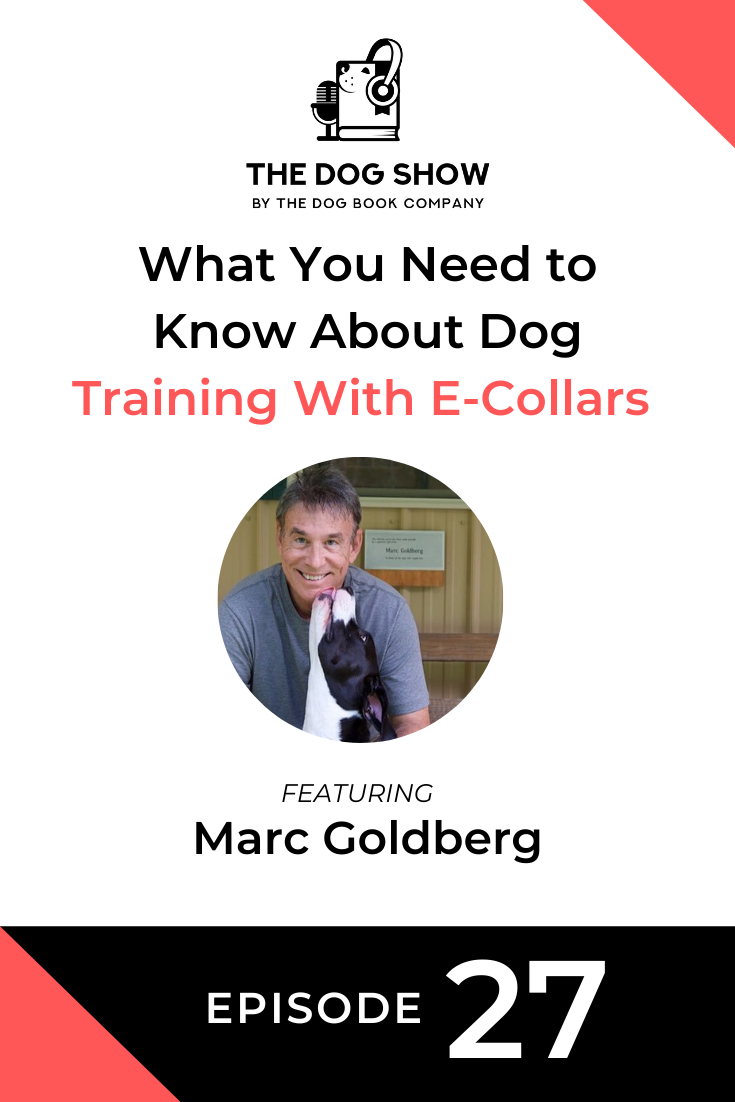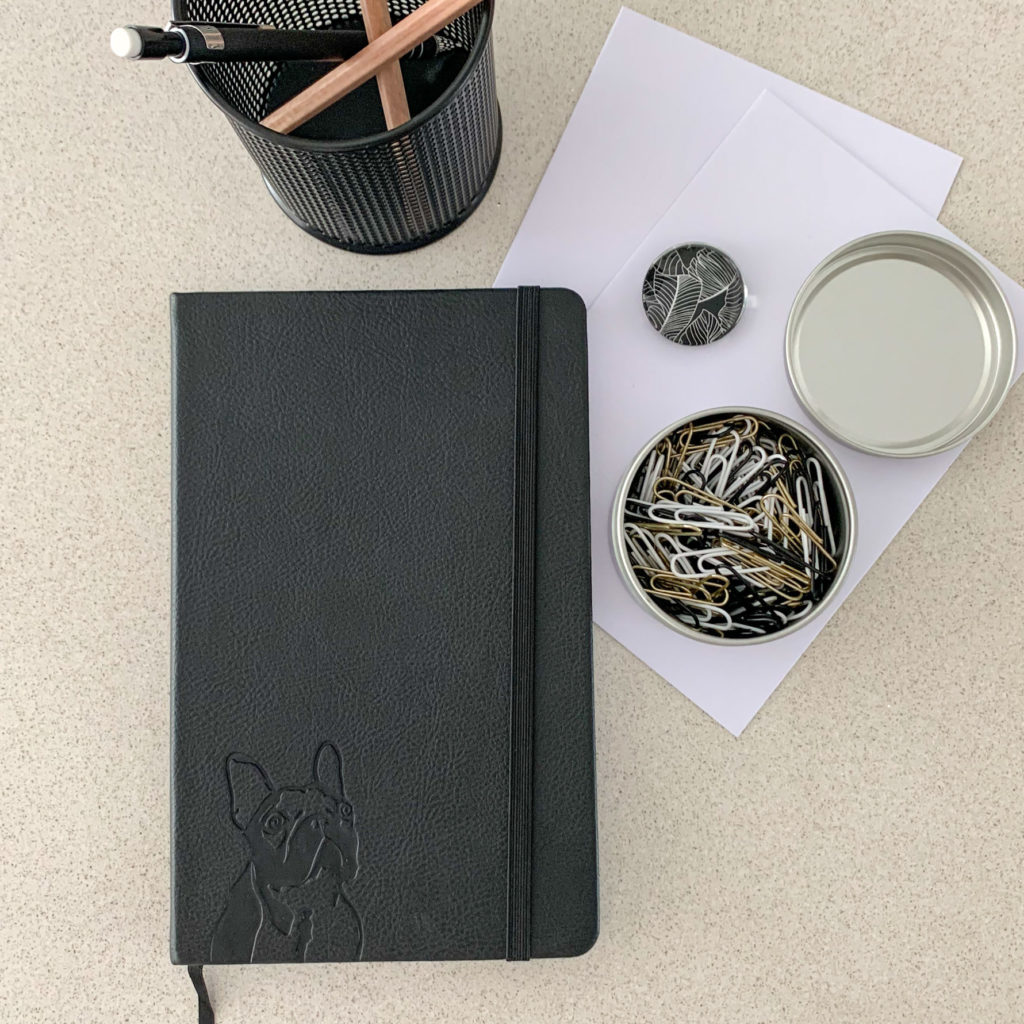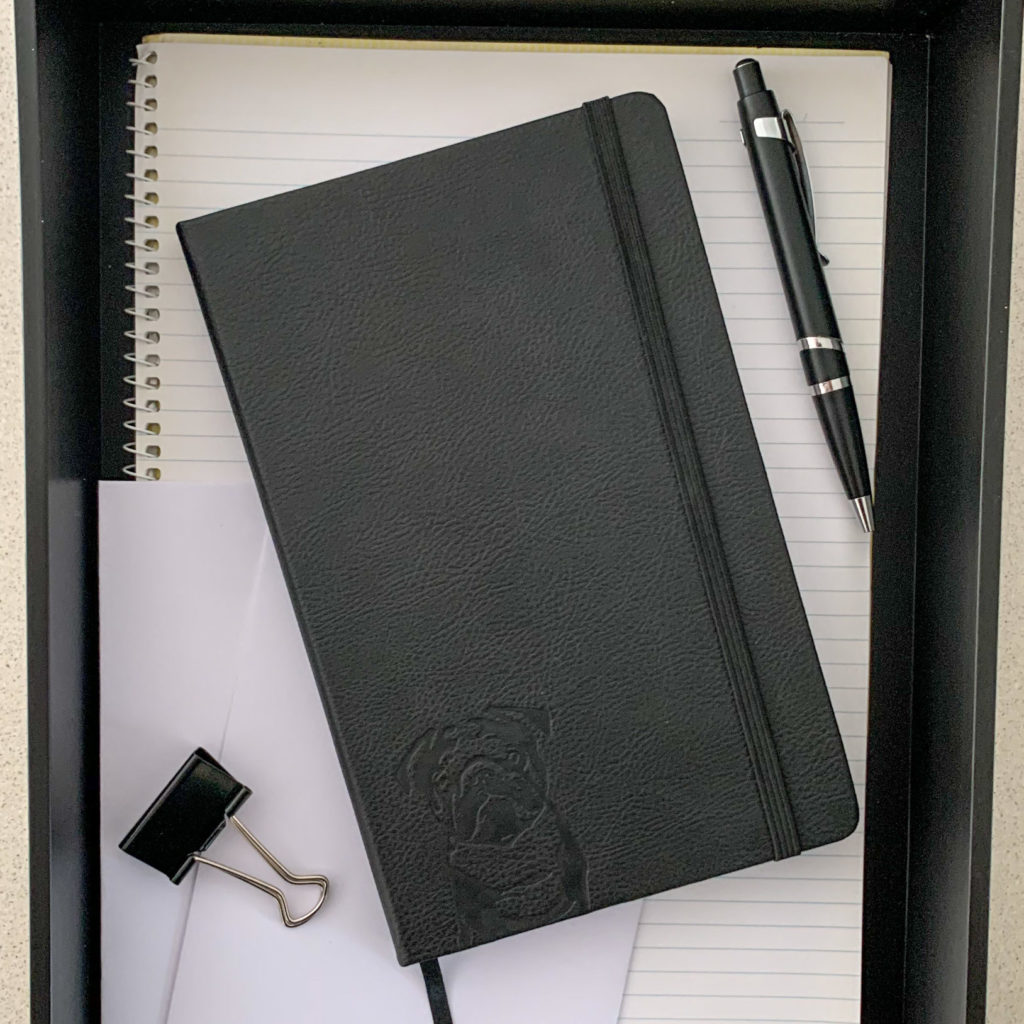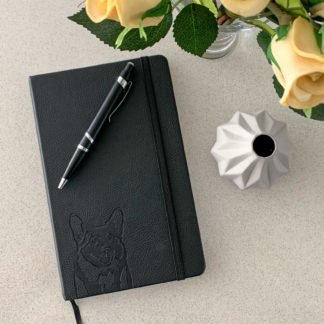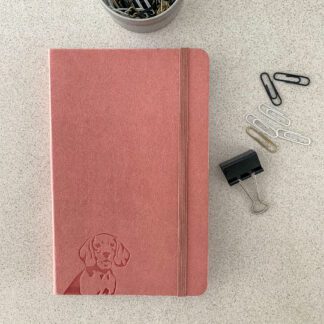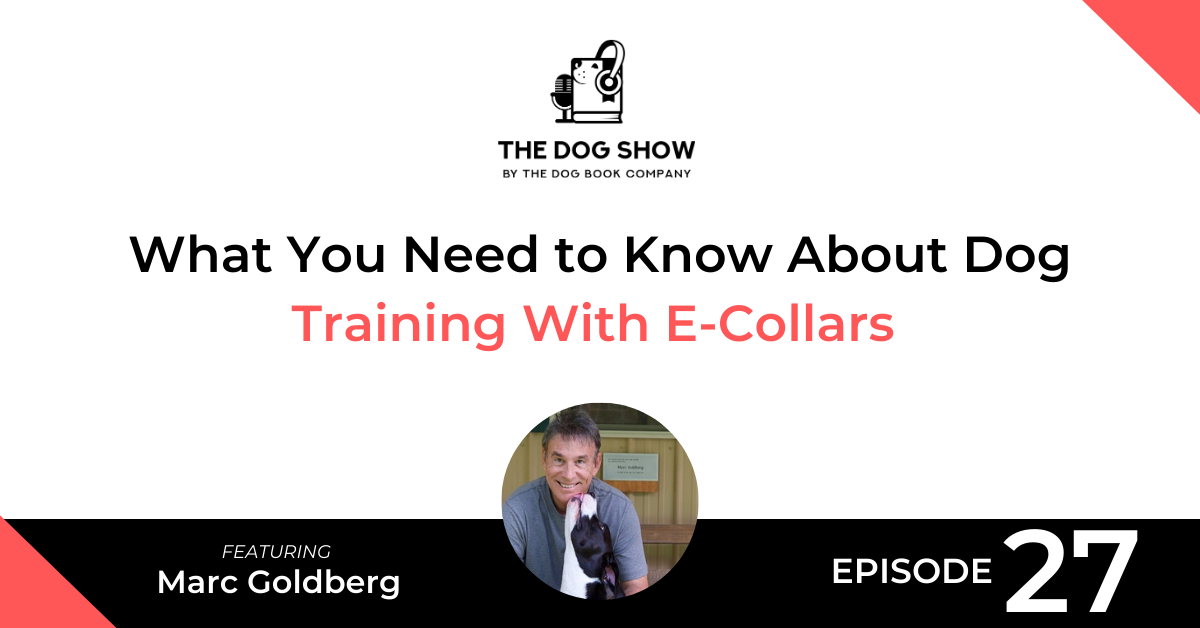
Dog training with e-collars is traditionally a controversial topic.
Is it ethical? Does it hurt the dog being trained? And does it work for changing behavior?
These were all questions I had before interviewing Marc Goldberg.
Marc is co-author of the book The Art of Training Your Dog, a unique guide for gently teaching good behavior using an e-collar.
This book introduces a breakthrough method in dog training. This method taps into a dog’s ancient pack instincts while employing state-of-the-art technology and a game-changing tool: the remote e-collar.
Marc has been training dogs for over 50 years and is a nationally renowned dog trainer. He is also the former president of the International Association of Canine Professionals.
In the interview, we discuss all things dog training with e-collars, including whether or not they hurt dogs, the types of behavior you can correct by using one, and the brands of e-collar you should be looking for.
Find out more about Marc and his book here:
Listen
Watch
Read
Will: This episode of “The Dog Show” features Marc Goldberg. Marc is co-author of the book, “The Art of Training Your Dog,” a unique guide for gently teaching good behavior using an e-collar. This book introduces a breakthrough method in dog training. This method taps into a dog’s ancient pack instincts, while employing state of the art technology, and a game-changing tool, the remote e-collar. Marc has been training dogs for over 50 years and is a nationally renowned Dog Trainer. He’s also the former president of the International Association of Canine Professionals. In the interview, we discuss all things dog training with e-collars, including whether or not they hurt dogs, the types of behavior you can correct by using one, and the brands of e-collar you should be looking out for. Marc Goldberg, welcome to “The Dog Show” today. Thank you very much for coming on.
Marc: Well, thanks, Will. I think I found the right show to talk to.
Will: Absolutely. We’re just talking before we jumped on the call that it’s the afternoon for you in Chicago and for me in Sydney, I’m just starting my day. But what a better topic to start the day on, chatting to a dog trainer across the other side of the world.
Marc: Well, I’m pleased. I’m definitely happy to be with you guys. Thanks so much for having me.
Will: Yeah, it should be a bit of fun today. We’re going to be discussing, as you mentioned, quite a controversial topic. We’re going to be talking about e-collars for training dogs. I’m quite interested to find out more about it because I’m a little naive in the space and I’m sure there’s lots of questions that all the listeners have as well. But before we jump down that path, I just want to hear a bit more about you. So tell me about, you’ve got your own dogs, I believe? You have three of them?
Marc: I do. I’ve got three dogs. Two of them are 16 years old. And let me tell you, that’s a challenge. They’ve both gone a little bit deaf. So it’s a relief that I taught them hand signals back in the day. And so I can still communicate with them. But I have a little 16-year-old Rat Terrier, which is sort of like a Jack Russell except for they don’t bite people, that’s the primary difference. And then I have a 16-year-old Border Collie Pitbull mix, I think is his mixture. And he’s got the best of both breeds. He’s got the very affectionate nature of the Pitbull and the very athletic intellect of the Border Collie. So he’s just a lovely boy. But they’re elderly now. And I have a three-year-old German Shepherd named Friday, because that’s the day we got her.
Will: Very nice. So it’s your two older dog started to slow down a little bit? When did that start happening?
Marc: Well, you know, I started to notice that when they were 13 or 14 years old. And actually, I haven’t needed to go to this method yet, but it has happened to me in the past, if I get my dog who goes completely stone-cold, deaf, utterly, completely deaf, when they’re younger, I do train them with e-collars. And the e-collars that I train with among other things can vibrate like a cell phone set the silent, you know, someone calls you it vibrates in your pocket. So my last German Shepherd when she went completely deaf, she would never know when she was outside if I wanted her to come back in the house. And I live on a beautiful little farm, it’s all fenced in, so at night, I might let them go out for their potty for 10 or 15 minutes. I’m close by but I could always just call her on her cell phone. If I wanted her to come back, I would just ring the pager and she would trot back happy as a clam. But she couldn’t hear me but she could feel me.
Will: That makes sense. Did you get your dogs from shelters or breeders or what was that choice?
Marc: Well, I am definitely not against the breeding of well-put-together dogs. Somebody has to make more dogs and somebody should be doing it not just randomly, but with forethought, with care, to improve the genetic selection of the breed, which is what The Monks of New Skete do with their German Shepherds. But as it happens, my three dogs are all rescue dogs. The Rat Terrier, her owner passed away when she was very young and they needed to find a home for her urgently. So I took her, I said I’ll train her and then I’ll find her home because I’m not a rat terrier little dog kind of guy. And, you know, like two weeks later, that was my dog. So we call that a foster fail and I kept her. The Border Collie, I was looking for one and he was perfect so I fished him out of a shelter. And the German Shepherd, she’s a very well-bred dog. I trained her for a client. I liked her a lot. And then they had some problems at home, they could not keep her, so they called and asked me to find her home. And I did. It was my home, she never left here. So I just got lucky that way.
Will: I guess, living on a farm, you wouldn’t traditionally think of a farm dog bang the smaller Rat Terrier dog. The Border Collie cross and German Shepherd makes a lot of sense, though, with the open spaces.
Marc: I’ll tell you what, though, if you go back in history, at least on American farms, probably the same is true for Australian farms every farmer had two or three of those little ratting dogs. And the reason is they all had and still do on the sheep units. They’ve got grain and when you have grain, you have rats, and when you have rats, you have spoilage. So all the farms had these little dogs that could just whip through the barn, find the varmints and wipe them out. So they were very utilitarian dogs, less so today. Today, we just keep them because they’re clever and cute.
Will: Yeah, that’s right. Especially the ones that are in the city because they don’t chase any rats.
Marc: Exact… Well, there’s probably more rats in American cities than there are on the farms these days, that for sure
Will: Yeah, that’s probably right. So, Marc, you’ve been dog training for over 50 years, you’ve got a huge history working with dogs and living with dogs. What got you into dog training, like, what attracted you to it?
Marc: Well, I was a child bride to this industry and I tell that story in my first book with The Monks of New Skete called, “Let Dogs Be Dogs.” And what had happened was, when I was a youngster, I desperately wanted a dog. It took me a lot of begging and pleading over a year but I did get a puppy for my 11th birthday. And let me just before I tell you this part of the story, I will tell all your listeners that this dog lived to a very ripe old age. I mean, I got him at 11, and he lived till I was almost 30 years of age. But when he was only five months of age, he ran into the street, was hit by a car, he was badly banged up. And so once we got him patched up and surgery it all together, when the cast came off, the pins came out, my mother did an amazing thing that just changed the course of my life, and that is she sent me in that dog to dog school, because she said, “If you don’t train him, he’s gonna get killed on that road that we lived on.” And the rest was really a bit of history because well, to make a long story longer, I was the only little kid in that whole class, there must have been 25 adults in that class, but my little Gus and I, we won the first prize. So I was kind of hooked from that, I was kind of hooked. And I’ll tell you what, it wasn’t long after maybe only two years later, that I was obsessively reading everything I could find on dog training. And that can seem to concern the librarian in my middle or junior high school, as we call it here. And so I would have been about 12 or 13 years old at this time and she queried me on, “Why are you reading all these books, but it’s only dog books?” And I told her that I wanted to be a dog trainer. And then the next thing I knew she called my mother, who apparently gave permission for me to go home with the librarian and train her dogs.
Will: Oh, wow.
Marc: Yeah, that was a different era back in the ’70s, right? You could just go home with your teachers. And here’s the end of the story. She gave me $5 for that hour. And that was a significant amount of money in that era, I’ll tell you that, it was a lot of money. So I scratched my head and thought there might be something to this. And that’s how I started.
Will: You were flexing that entrepreneurial muscle at a very young age there [inaudible 00:08:26].
Marc: It’s like 12. But to me, it’s an incredible thing when you discover your passion, your drive, your identity at a young age, because they say it takes 10,000 hours to become unconsciously competent at a thing. And it probably took me 20,000 hours because I wasn’t that good at it at first. But I had the time, I was young and I devoted all the time and energy in the world to it because I wanted to understand. It wasn’t so much that I wanted to make dogs do things. For me, it was never about being in control of a robot. What really, really drove me then and drives me today is to understand what are they thinking? Why do they do what they do? What do they need from us? How can we be better friends to our dogs? How can we make them happier? And how can we keep them safer? So that was really it for me.
Will: You’re very fortunate to have found your passion at such a young age. I certainly took me a lot longer. I’m probably another 20 odd years until I was down the dog path. But you’re very lucky to have spent so long working in this space.
Marc: I agree. I think it was a stroke of luck. But you know better late than ever, welcome to the party. It is a great way to make a living and you meet some wonderful people also, it’s not just about the dogs. This is a helping profession. We help people if things are out of sorts with the dog, the whole home environment is usually messy and upsetting. So I really think we help people and families.
Will: Interestingly, I was looking at the photos on your website, and you’ve got photos of so many different breeds of dogs that you’ve trained. And I noticed there’s a French Bulldog bang in the middle because I have a French Bulldog.
Marc: They’re so cute.
Will: Yeah, there was poodles, there was all sorts of different dogs on there. Do you have insights on how hard it is to train different breeds, or is there any breeds that are harder to train? Or is it more about the upbringing and that kind of stuff?
Marc: I think it helps if you know the genetic makeup of a breed, like what drives them? What motivates them? What do they want? And for example, a lot of people, a lot of dog trainers, or even owners don’t like training let’s just take beagles as an example, they find them obtuse, thick-headed, stubborn. But I don’t think that’s fair. I think we have to remember what the beagle was bred to do. The Beagle was bred to have one of the most incredible noses on earth, right? And what they want to do is they want to utilize it. So when I train beagles, all I teach them is, I will trade you a sniff for where the raccoons and the rabbits pee in return for a recall and just the basic obedience so you don’t get killed out there. And once they understand that you are the great hunter that you know where were all the good stuff is and that you will reward them with what they most want, the right to be a beagle, the right to use that nose, but that it’s a partnership, and you have to do it together, they give you whatever you want. And the same is true of Huskies. For example, a husky wants to run, I mean, they are just bred with an incredible amount of drive. They’re bursting with energy and they want to run. And people say that it’s impossible to train them to off-leash, reliability, and safety. But that’s poppycock. I’ve trained dozens and dozens of them to it. But what you don’t take the running out of them. All you teach them is, “Run this way, now come on, and let’s run that way, now run to me, here’s your treat, run that way” You just teach them where to do it, and how to turn and how to recall. Because if you think about it, the Huskies were bred to pull sleds in Alaska, but some of them must have come home at night, or there wouldn’t be any anymore. So it’s a highly, highly trainable though. The French Bulldogs are bred for selective hearing, and I’m sorry for the French, you know, the members of the French public in the audience, you know, but the French are very discriminating in terms of what they will eat and who they will make friends with. But then, what I have noticed is the average French Bulldog, Will, will sell his soul and you for a treat or a squeaky toy because they tend to like both. So you just need to engage the mind of the dog. And so, now I don’t think there’s a stupid breed. I think that you just need to understand what they want and trade them what they want for what you need from them.
Will: Yeah, my French Bulldog certainly will take attention at any time. So it’s interesting, though. So it sounds like what you’re saying is, you’ve really got to understand maybe the history of the dog, but also the dog itself and just harness it’s kind of tendencies rather than trying to stop them.
Marc: Well, listen, it’s a lot easier to swim with the tide than against the tide, right? So if you understand what a dog wants, what a dog needs, how to communicate to that dog, it’s a lot easier to convince them that they should try the behaviors that you’re offering them. A lot of that kind of hypothetical thinking, there’s a lot of that appeal to the nature of the dog and the instinctive nature of the dog. In fact, in our book, “The Art of Training Your Dog,” yes, we teach our readers how to teach their dogs, obedience, but it’s all framed up in ways that work to harness the instinct of that the dog has to please, to please their owner in the first place. And when you work with a dog… Well, let me phrase it like this. Training is not something you do to your dog, training is something you do with your dog. And if you do it, with that thought in mind, everybody’s going to have a good time as opposed to just getting bossed around. Nobody wants to be bossed around a lot.
Will: All right. Okay. So it’s a good segue that you mentioned your book, “The Art of Training Your Dog,” for many, many years, you trained without e-collars…
Marc: Correct, yeah.
Will: …and then at some point in time, you changed your methodology to start using an e-collar. What was that reasoning and kind of how did you go on that journey?
Marc: Well, I was actually very anti-e-collar, but that was based on my early experience in the ’70s. And the reason is, is that e-collars were around even back then, I think they go back at least into the ’60s. But they were big and they were ugly. And I put one on me back in probably 1972. For reference guys, I’m 62 years old. And so back when I was a kid, in 1972, I put one of these on my hand and I pushed the button and it almost knocked me across the room. I mean, it was brutal. What did they use them for back then? Well, in this country, as probably in your country, it was then and in certain parts of the country still is legal for a farmer to shoot and kill a dog that’s harassing livestock. So, for example, if you had a sheep killer, that dog was going to get killed. Even if it was a sheep chaser, someone was going to kill your dog. So it could be used for breaking habits like that. But that was all it was good for. It certainly wasn’t good for any kind of meaningful training on a dog that you loved. And therefore, all my opinions about that were based on that thing that I knew. Now, also at that time, I was writing, I always loved to write and I started out by writing longhand, and then eventually I got a typewriter, which you probably, you know, you’re probably so young you don’t even remember a typewriter. But I mean, you literally click, click, click, click. And then things got really fancy and I got an electronic typewriter so you didn’t have to like slam the carriage over, you just pushed a button. Well, I guess what I’m saying is now I have a computer. Technology advances. It doesn’t hold still for anybody. And technology in training collars in electronic training collars is the same thing. It miniaturized, it got better. Are all the electronic collars out there today good or are they all good? No, most of them are not good. Most of them, I wouldn’t put on a dog I disliked, okay?
But there are a handful of companies who have devoted millions of dollars in research and development money to produce e-collars or electronic collars that you can put on your hand and push the button and feel it over and over and over and over and detect it, but not be upset or worried about it. And that offered a lot of opportunity to dog trainers. But I guess the hard part then was to figure out how to use the technology. Good technology, if it’s not matched with good methodology, you got a problem. And that was the problem that we put ourselves to solving, was to figure out, okay, back in 2000, companies started coming out with really unique, amazing new equipment but nobody knew how to use it well, and that was the challenge that The Monks and I faced, was to decipher that and decode, how can we use this stuff better?
Will: Before we jump into your methodology, I want to talk a little bit more about the e-collars. So what I understand is there’s a grading system or something, is there, like, there’s a one-level shock? Is that how it works?
Marc: Well, okay. So first, let’s distinguish between what is a shock collar, and what is an e-collar? Okay? And bear in mind guys, I’m not an electrical engineer. I’m a simple dog training author. Okay. But I will tell you this, there’s certain cheap collars where the electricity passes through you. But then, there’s other ways to transmit electricity like, in this country, we have got TENS unit, which is a transcutaneous method of passing electricity. So for example, I’m sure they use them in Australia as well. You hurt your neck, so you go to the doctor, the physical therapist, they put some pads, electrical pads like EKG pads on your neck, they feed low-level electronic stimulation into your neck, you can barely feel it if they keep it at a low level. But what it’s doing is it’s gently massaging the muscle, which brings extra oxygen to the muscle which is therapeutic and healing. Okay? So there are some of the e-collar manufacturers have figured out how to engineer their collars to do exactly that. And at the lower levels, if it’s on your fingertips, you feel a light tingle. If it’s on a muscle, you feel a very low twitch. That’s what we’re after for the dogs. We don’t want to pass electricity through their body because that’s really unpleasant.
Will: It’s a taser, right?
Marc: Yeah. Well, I mean, listen, when I was a little kid, I don’t know why but I was bound and determined to figure out what made the light bulb go, okay? And my mother constantly was stopping me from playing with the light bulb in a lamp. But one day she took her eyes off of me, I unscrewed the light bulb, put my finger in the lamp and I found out, okay, what makes the light bulb go and I never did it again. That electricity passes through you, it travels up the arm. It’s very, it’s decidedly unpleasant. Here it’s 110, I don’t know what it is by you, but it was not nice. E-collar it’s not like that. It’s just going a few millimeters into the skin. That’s all.
Will: I had a similar experience as a kid, it wasn’t an electrical one but my mom kept telling me, “Don’t touch the stove, don’t touch the stove, it’s hot.” But as soon as she left the room straight onto the stove.
Marc: That’s good teaching right there.
Will: You said they learned quickly by doing that but… So I guess with these e-collars, you mentioned that you put it on your hand and you’re comfortable with putting it on your hand. Would you put these collars on your neck and be happy that they weren’t going to hurt you?
Marc: Yeah, of course. Look, let’s start with the following stipulation, guys out there if you’re worried that, you know, I don’t want to hurt my dog the sounds sketchy, you’re questionable. I don’t blame you for wondering that, but let me assure you, in the book, we talk at great length about how to select a high-quality e-collar, number one. And number two, we talked at great length about how to use it. Because it’s a nuanced conversation. You really need to know what constitutes are really unusable e-collar. What constitutes are good one? And then once you’ve got a good one, how do you use it to engage your dog, to teach your dog that it means, “Excuse me, I want to talk to you about something.” And as often as anything else, that means, “I’ve got a treat for you. Give me some focus. Come here and get your treat.” But if you punch me, and then give me a $20, bill, I won’t enjoy the punch or the $20 bill, right? But if you tapped me on the shoulder and go, “Here’s the $20,” if it’s a light touch, yeah, I’m gonna engage and be happy, and so will a dog. So there’s a lot to know about this, but I guess I would sum it up with the following thought. Concern and controversy and distaste for electronic collars, it’s understandable, but it’s based on outdated equipment and outdated methodology. We got the new stuff for you and it’s really good.
Will: I guess, you’ve convinced me that I think what needs to be done if you’re going to start using an e-collar for training, is to do your research into the actual product you’re getting, speak to trainers that have used them, or read your book, for example, and really understand what you’re getting yourself into, and how to use it properly before going down that path. I think that would, for me personally, as a dog owner, that would make me feel more comfortable about using something like this.
Marc: That’s absolutely critical, you’re so right. Look, here, in North America, manufacturers believe that approximately 1 million units are being sold per year. Some of them good, some of them not good. The Monks of New Skete and myself, we both run board and train program. So among the things that… I do Zoom consultations for clients, so they could be anywhere in the world. But my local market people in the Midwest of the United States, they bring me a dog, and they come pick up their trained dog a few weeks later and learn how to keep it trained. And some of them actually bring along an e-collar that they have purchased over the counter someplace at a store. And almost universally, they tell me, “You know, I tried using it and I gave up quickly because I upset myself or I freaked out my dog, or when I opened it and started to read the instructions, I got scared because it really didn’t inform me what to do, how to use it.” So a lot of people buy them and then realize, “I’m in over my head.” And sometimes those are good e-collars and we can use them, other times we tell them to return them and we’ll supply a better one. But always you need education. Look, you can buy a kid a car, but you better teach them how to drive it before you just hand them the keys. And this is a lot like that, I think.
Will: I think that’s the same with many training methodologies for dog owners. I mean, the dog owner needs to be educated and trained themselves for the actual training to work, right?
Marc: Well, always. Always that’s true. Yes, but I think it’s probably even more important when we’re talking about power tools, right? A leash is a really important tool, but there’s probably a limit. Unless you’re a brutal, terrible person, there’s a limit to how much damage you’re going to do psychologically to a dog with a leash, you’d know you were messing it up and ideally, you’d stop and seek assistance, right? But with an e-collar, there’s buttons, and you need to know what you’re doing. The advantage of it, though, here’s the advantage of it. I’ve been training dogs a very long time, and I trained dogs for many years before I would ever want to use an e-collar because they were no good. And I taught dogs to come when called, even if there was a squirrel, and a lot of people have done that. I’m not the only one. I didn’t invent that. But let me tell you what. It took about 25 weeks of training, on the average dog to really get a dog reliable around heavy distractions for a recall, 25 weeks, 20… Yeah. And you needed to train that dog approximately an hour a day and two half-hour segments at least five days a week so count up the hours and the weeks. Most people never did that. And consequently, most dogs never really fully became reliable. We’re doing it now in two or three weeks, two or three weeks, right? And by the way, I want to stress this, with dogs who enjoy the process because we’ve built it into their instinctual behavior and we’ve made it fun for the dogs so the timeline is so much better now. It is not trained with fear, is trained with joy, that’s really what we want… What we want is we want dogs who enjoy the training.
Will: I definitely think that acceleration aspect is in terms of accelerating the process is a very attractive part of it for me because I know that where we’re falling over in the past trying to train our dog to do certain things is just that discipline and patience of doing it over and over again, over a period of time, right?
Marc: I have an incredible amount of patience with dogs but it seems like I focused at all in that area and for everything else I’m a disaster as far as patience goes, right? But for that… And I think the reason that I’ve cultivated the ability to really focus on getting the best out of the dog is, is because I know it works. And I also know it’s the only thing that works is for you to be fair and patient and consistent and to read the dog well. You know what? Half the battle of a dog training session is knowing when to stop, right? More is not better, in a lot of cases. So in “The Art of Training Your Dog,” I would say most of our lessons are anywhere between five to 15 minutes, we want to keep them brief and punchy and happy and leave the dog wanting more rather than wanting less.
Will: Okay, so in “The Art of Training Your Dog,” your book, it’s basically a step by step guide from what I understand of how to use e-collars to gently teach good behavior to dogs…
Marc: Yeah.
Will: … and then you recommend a process for finding the right e-collar, all that kind of stuff. But what does your methodology look like? And how do you teach a dog to do something using an e-collar?
Marc: Yeah, no worries. So well, first, what we do, I’ve told you that The Monks and I, in our professional programs are teaching all the way up obedience and good behavior, manners, problem-solving, from soup to nuts, in roughly three weeks. In the book, we decided to slow it down a little bit, because we’re professionals, like we just do this all day, every day. So we know what we’re looking at. In the book, what we did was we came out with a daily planner, it tells you what to do every day for six weeks, at the end of six weeks, you’ll have a fully trained dog. And by fully trained, I mean a dog, you can go hiking with off-leash, someplace where it’s reasonably safe, you know, I wouldn’t do it down the middle of a divided highway, right? But you could go into off-leash safe areas, play with your dog, and know if he scares up a rabbit, you’ll get them back readily. A dog who go to bed lay down when asked and so forth. So we start out by introducing the training collar and we merely teach the dog that, this little tap on the shoulder, this little funny feeling that’s unimportant, it’s so low, what we’re shooting for, we call it the educational level, by the way, is a sensation delivered to the dog, that he will feel as though somebody tapped you on the shoulder. And just as we do that, what we do is we turn around and walk the other direction. In fact, we start training indoors. We start training in the house because there are fewer distractions in the home number one, and also a lot of people struggle with bad behavior in the house. So it’s a really good way of starting low key gentle, easy training. And all we do is walk them from one end of the house and just as the dog is gonna pull ahead of us, we tap the button and turn around. There’s pictures of this to make it clear, what to do, actually, there’s a couple 100-collar pictures in that book.
But the essence of the thing that we start with is the button has one very simple significance. Tap on the shoulder means, “Hey, buddy, we’re turning the other way.” And ultimately, then, we can teach the dog now it has other contexts, we can pair the tap with the command that the dog probably already knew, for sit, but we use the help mold the dog. We’re never yanking or cranking on the dog at all. We’re never cranking up the collar and saying, “Do it or I’ll make you sorry,” never. It’s a question of helping the dog achieve it and understanding the tap from the e-collar means, listen to the word, now that we’ve put a word to a command and do the word. And there’s a food treat. And in fact, well, let me show you my little Murphy here. Here’s Murphy, right? So we put a food treat right to his face and help him to sit. So the food treat is a cue that we want the dog to sit, the word is a cue, the lifting of the treat is the cue, all to help the dog sit. But so is the tap of the button. The value of it is, is that we can use it eventually from a distance. So if we want a dog to sit 30 or 40 feet away from us, we can just tap and tell him and he’ll do it, then eventually we can eliminate the tap because the E collar is a tool to be used and then eventually faded back, way back.
Will: Yeah. So I think that language you use is very helpful in the sense that rather than saying things like shocky, say, you know, like, sensation. I think that helps me understand kind of what the process looks like, as well as talking about the tap on the shoulder rather than what people might associate with the old e-collars.
Marc: Well, you see your dog, if I may, just let me put this out there. If you push a button and you see your dog jump or exhibit any sign of discomfort, you’re doing it wrong. And we can help you with that. That’s not what we’re after.
Will: Well, I guess that’s the technology equivalent of like hitting them or something, right? If that in spectrum, which is not…
Marc: That’s right. Yeah, absolutely.
Will: …not even training methodology that so…
Marc: That’s right.
Will: But what I’m hearing is if I get your book and I use that to try and train my dog, I’m looking at a six week kind of process starts in the house, slowly build up to eventually be using e-collar in a more kind of open environment. Do that sound like a good summary or…?
Marc: Absolutely yeah. We start in the house and what we begin to teach in the house are good leash manners. We start teaching sit in the house, and then we move quickly to sit at the doors. Because a lot of people have the problem that children open the door and the dog bolts out, now they’re chasing the dog down the street. Or the pizza delivery guys there, and now the dog is gone, you know, ape at the door. So we teach sit, we teach sit at the door to lower door friends, we teach the dog, it’s a control point. And then we begin teaching the recall or the come one called the come command, we teach that we start that in the house too. But we are simultaneously advancing to teaching leash manners, then outside recall, outside sit, outside even when there’s distractions, and then we take our six-foot leash, and we turn that into a 15-foot leash, which is, are you guys imperial, or metric?
Will: Metric. That’s okay. Go on then.
Marc: Yeah. Well, we start with a 2-meter leash, but we work our way up to a 5-meter leash. And eventually, by the way, that 5-meter leash, we let go, and it’s dragging along the ground. And within a reasonable amount of time, if you haven’t had to chase the end of that leash to step on it and stop your dog and take it off, or we talk you through how to use a lighter, longer leash, but eventually to eliminate it. So it’s a very careful sequential progression from training with a leash in your home, to training with a leash outside where there is slightly higher level of distraction, to doing all the same stuff, but on all very long leash just for safety and control until you both get your sea legs and your bearings. And, by the way, a dog who is psychologically connected to you, you know it, he notice this the bird, but he doesn’t stare it, he checks back to make sure you’re still coming. When we decode it for you, it’s very easy to know, if your dog is plugged into you, psychologically. And then eventually, there’s no leash at all. The mark of any dog training system, in my opinion, and the opinion of The Monks of New Skete, it’s multifaceted. Does it help eliminate conflict from your life? Do you have to… Can you stop nagging your dog? Number one. But number two, does it grant liberty to your dog, to be a dog, to run, to play. And to be able to do that outside, where it’s legal and safe and sane to do it, go to the dog park, go to the beach, you know, they need that but they need it from a position of safety. So does the dog training system, get the dog off-leash reliable, quickly, and happily around distractions? If not, then I don’t really know what you’re accomplishing. That’s what we want, anyway.
Will: That’s a great point. It’s something that I would resonate with is, you want your dog to have some freedom and to really go and enjoy things but if you’re worried or anxious that they’re going to have bad behavior in that scenario, then you kind of just restrict them from doing that, and then you’re not happy, they’re not happy. So they have to teach them better behaviors in those environments would be very, very good.
Marc: Yeah, we really want you to be able to take your dog to the beach, to the cafe, to the woods. We want your dog to be able to go hiking with you. The key point is, is that you got a dog for was companionship, you know, you didn’t get them to lock him up. The problem, of course, is here’s where at least were many Americans, I think, go wrong, and that is they adopt a dog, and they immediately want to jump to being that that dog’s grandparent, but you got to be the parent first, you got to teach him to stay out of jail before you can just rile him up and take what you need out of the dog. They have rights too. And one of their rights, in my opinion, is education. And here’s why, your dog wants to go with you. If you don’t trust them if he’s naughty, then he’s gonna spend his life locked up, and that’s sad. You know, if you train them, you can take them with, and that’s what he really wants.
Will: So what’s up is you spoken about those kind of core commands such as sit, stay, recall, is that, I guess the essence of being able to correct bad behaviors as well?
Marc: The average client who comes to me for the boarding school, they usually don’t come saying, “Listen, I just want a beautifully trained dog,” once in a while, but usually it’s not that usually, it’s like, “Look, man, this dog eats off the counters, he knocks over the kid, he growls at the mail, man, he like, he’s scratching my back door when he wants to come in.” I mean, the list goes, “He steals laundry, he doesn’t come when on called, he’s got selective hearing, I’ve got potty issues.” I mean, when you hear this list of stuff, sometimes makes you wonder, why do people get dogs? It’s incredible the amount of awful things they can do. They dig holes. I had a client dog who in one afternoon, when he left the dog in the fenced-in yard, pulled $25,000 U.S of landscaping, right out of the ground, including the entire sprinkler system.
Will: Wow.
Marc: It’s amazing what they can do. By the way, there’s an appendix in the back of, “The Art of Training Your Dog” which lists 45, the 45 most common problems we ever hear, which includes that list I just gave you and a whole bunch more. But what you started by saying was if you train your dog, is that how we approach those things? The answer is you bet. I mean, we don’t start by punishing a dog for bad behavior. First, we teach them the rules of civilized behavior. So if you train your dog, and we say this repeatedly in the book, before the problem section, which we put on purpose, we purposefully put that section in the back. If you train your dog, the number and intensity of problems you have, they’re gonna dissipate or disappear. But they’re for sure going to de-escalate, decrease. And the reason is, the vast majority of naughty dog behaviors, those are caused by boredom, and frustration, which is what untrained dogs usually suffer from. And then all that creative energy has to go into something and it’s going to be something bad. So if you educate your dog and spend quality time with her, then she will be less bored, less frustrated, and probably you’ll see a big decrease in problem behaviors. But if you still have them, we got your solutions.
Will: Make sense. And I think as well, you know, I certainly look at bad behaviors, as it’s my fault. I haven’t given them the tools they need to make the decisions that I want them to make in those scenarios, so.
Marc: Well, you know, most of us feel vaguely guilty if we raise the kids wrong.
Will: Exactly.
Marc: It’s never too late. It’s never too late.
Will: That’s part of the problem when you’re out and about it’s and people say your dog doing bad things, it makes you uncomfortable, right? But…
Marc: Imagine being a dog trainer and your dog is naughty. So you really have to train your dogs so that you’re not embarrassed to give out your card.
Will: That’s comforting to know that maybe even a dog trainers dog will have bad behavior sometimes.
Marc: Listen, let me tell you. No dog is perfect. And, by the way, no dog should be held to accountable for a perfect score. They’re living breathing beings with rights and emotions and desires and stuff. So I look at it like this, I want a partnership with my dog but I want to be the senior partner, I want 51% of the corporation. And the reason for that is I know what’s safe for him in a way that he does not know. But other than that, nobody’s perfect, and neither am I. So I don’t mind a little bit of shenanigans on the part of my dog, I just want him to be safe.
Will: So do you have a brand of e-collar that you recommend or the use for training?
Marc: Well, we talk a lot about that in the book. And I can mention some brands here but you got to look at the individual models. And I recommend that you don’t just take this little component of this interview. This is for the guys out there. And, you know, listening to this, and just run with it, because there’s a lot more to know than just this. But there are some really good brands that I’m very familiar with. One is called E-Collar Technology, another one is called Dogtra, another one is called BigLeash, another one is Garmin. And then also there is the SportDOG brand. And there are probably others that I’m accidentally admitting and if so, I’m sorry. But those brands have many models that fit the bill for what we’re looking for in an e-collar that can be used gently.
Will: Okay. Well, thanks for sharing that. So where can people find out more about the book, theartoftrainingyourdog.com, I believe is the best place to go and they can also check out your website as well?
Marc: Yeah, my business website, my personal business website is chicagodogtrainer.com, or theartoftrainingyourdog.com, where you can learn more about both me and The monks of New Skete and the book.
Will: Perfect. Well, I’m excited to start diving into the book, it got released last week, I believe, is that right?
Marc: It did. It just started shipping recently and we’re really thrilled it’s the number one new release in dog training on Amazon here in the states and seems to be getting some good reviews that… You know, but we’re happy to have it in the world. We put a lot into it. But the idea really was to help people in dogs that was the goal.
Will: Well, that’s exciting. And thank you so much, Marc, for coming on, “The Dog Show,” today. I had a really good time. I learned a huge amount about e-collars but also just about understanding my dog and understanding the process of training a dog to have good behavior by using an e-collar and using a good mindset. So thank you so much for sharing your expertise with the listeners.
Marc: Will, thank you for having me. I really enjoyed our time.
From Our Store
-
French Bulldog Coffee Table Book – The Book of Frenchies
From: AUD $59.99 Add to cart -
Dachshund Coffee Table Book – The Book of Dachshunds
From: AUD $59.99 Add to cart -
Pug Coffee Table Book – The Book of Pugs
AUD $59.99 Add to cart -
French Bulldog Notebook – A5, Hardcover, PU Leather, 100gsm Lined Pages, Bookmark (Three Colours)
AUD $34.99 Select options -
Dachshund Notebook – A5, Hardcover, PU Leather, 100gsm Lined Pages, Bookmark (Three Colours)
AUD $34.99 Select options -
Pug Notebook – A5, Hardcover, Black PU Leather, 100gsm Lined Pages, Bookmark (Three Colours)
AUD $34.99 Select options -
French Bulldog Planner – PU Leather Exterior, Metal Loose Leaf Ring Binder, 100gsm Paper (Two Colours)
AUD $64.99 Select options -
Corgi Notebook – A5, Hardcover, Black PU Leather, 100gsm Lined Pages, Bookmark (Three Colours)
AUD $34.99 Select options -
Dachshund Planner – PU Leather Exterior, Metal Loose Leaf Ring Binder, 100gsm Paper (Two Colours)
AUD $64.99 Select options -
Vizsla/Weimaraner Notebook – A5, Hardcover, PU Leather, 100gsm Lined Pages, Bookmark (Three Colours)
AUD $34.99 Select options -
Cavoodle Notebook – A5, Hardcover, Black PU Leather, 100gsm Lined Pages, Bookmark (Three Colours)
AUD $34.99 Select options -
Beagle Notebook – A5, Hardcover, PU Leather, 100gsm Lined Pages, Bookmark (Three Colours)
AUD $34.99 Select options
